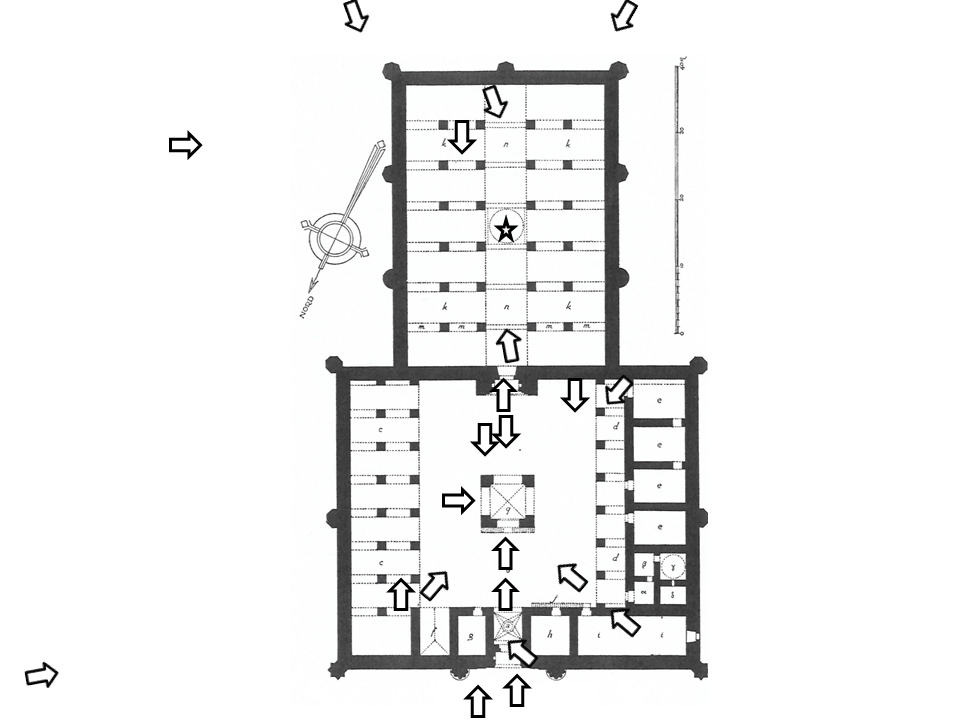Niamh Bhalla
The Sultan Han, located around 50 km northeast of Kayseri in the village of Tuzhisar, is the second largest – and one of the richest and most complete – Seljuk caravanserais to have survived. It is dated to 1232-6 by comparison with the Sultan Han at Aksaray.
The complex has two parts: an open courtyard leading to a covered hall. Fifteen polygonal buttresses – six at the corners and nine along the walls – dominate the exterior of the han, giving a strongly militaristic appearance to the structure which emphasises its role in providing shelter and protection to those traveling the major caravan routes of Seljuk Anatolia. The whole is constructed of finely cut limestone and the exterior walls are punctuated intermittently with striking lion-headed water spouts and a few slit windows. These windows are situated quite far above the ground and give some illumination to the rooms. Entrance is gained by the sole north-facing portal which is slightly offset to the east in the main façade. The entrance is flanked by engaged columns and the portal itself was decorated with ornate carved panels of varied polygonal, geometric and interlace designs. Much of this has been lost, with the few surviving fragments preserved in the recent restoration. The entrance is surmounted by a muqarnas niche, which is now also badly deteriorated, embraced by pointed archivolts.
The entrance passageway is covered by a vault articulated as a four-pointed star by the intrados of the arches and surmounted by a half-dome on pendentives. The lunettes on either side have a fan pattern, similar to that seen at Saghmosavank. The passageway is flanked by two vaulted guard rooms. Yadigar, the architect, is named in an inscription on the portal. Beyond the entrance passageway an expansive rectangular courtyard unfolds, flanked by a portico of seven bays both to the east and to the west. The eastern portico – which is two bays deep with two rows of pillars supporting its barrel vaults – may have served as stables and loading bays for goods. The western portico is only one bay deep with a suite of barrel-vaulted rooms occupying the remainder of the space between the portico and the outer wall of the han. To the northern extent of this wing, a set of four small rooms seem to have constituted a bath complex or hamam, and kitchens. It is because this western flank of the courtyard is wider than the eastern side that the entry portal does not open in the centre of the façade.
Another monumental portal gives access to the large covered room to the south of the courtyard. It too is of a traditional Seljukid appearance with its muqarnas vault and surmounting pointed archivolt. The portal is decorated with a variety of geometric interlace designs. The covered hall comprises a central aisle orientated along the same axis as the main portal of the han, flanked by seven barrel vaulted bays to either side which would have accommodated travellers and/or their animals. At the centre of the room a cupola rises on four pendentives decorated with projecting interlace rosettes. The drum is pierced by four cusped openings and decorated with blind arcading contained within two moulded cornices.
A two-story mosque executed on a square plan stands at the centre of the courtyard. The lower storey comprises a vaulted and open-sided portico supported on four pointed arches. The north side has a pair of corbelled staircases which lead to the prayer room above. The upper room is lighted by two windows with small muqarnas niches on their exterior. A mihrab is situated in the south wall. The finest sculptural decoration of the han is found on the exterior of the mosque; a combination of meanders, geometric motifs, interlace and rosettes. The most unique decorative motifs are perhaps the snake-headed mouldings beginning at the keystone of the external arches, which face to the south and to the east, their bodies stretching along the voissoirs.
Inscriptions in TEI: nos. 32900, 37406: http://www.epigraphie-islamique.org/epi/login.html
Interactive Plan

Image Gallery
Bibliography
- Acun, H., ed. Anadolu Selçuklu Dönemi Kervansarayları (Ankara: Kültür ve Turizm Bakanlığı Yayınları, 2007), 173-193, bibliography at 460-461; 463; 535.
- Bektaş, C. Selçuklu kervansarayları, korummaları ve kullanılmaları uzerine bir öneri (Istanbul: Yapi-Endustrie Merkezi Yayınları, 1999), 114-121.
- Erdmann, K. Das Anatolische Karavansaray des 13. Jahrhunderts vols. I-III (Berlin: Verlag Gebr. Mann, 1961-1976), 90-97, no. 27.
- Gabriel, A. Monuments turcs d’Anatolie vols. I-II (Paris: Ed. De Boccard, 1931, 1934), 93-98, pl. XXVIII, XXIX, XXX, figs. 60-63.
- Hillenbrand, R. Islamic Architecture: Form, function and meaning (New York: Columbia University Press, 1994), 347-349, 552, figs. 6.44; 6.45, pls. 250-251.
- Karpuz, H., Kuş, A., Dıvarcı, I. & Şimşek, F., Anadolu Selçuklu Eserleri (Konya: Selçuklu Belediyesi Kultur Yayinlari, 2008), vol. 1, 473-474.
- Talbot Rice, T. The Seljuks in Asia Minor (London: Thames and Hudson, 1961), 206.


